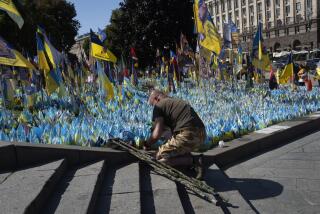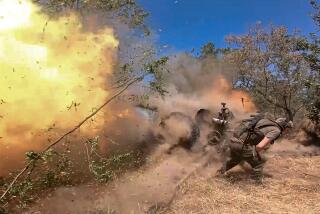Kurds Celebrate Win Over Militants
DEKON, Iraq â There was a picnic in the valley and mortar fire in the hills Sunday in this far corner of northeastern Iraq.
Kurdish leaders sat with American commanders, eating kebabs with plastic forks and celebrating their victorious three-day battle against a group of Muslim militants. Between nibbles of zucchini and sips of sugared tea, distant explosions offered a reminder that the extremists retained a bit of firepower, but the rumbling interrupted nothing: Peace is relative in northern Iraq.
The Kurds in Dekon are used to fighting. They have lost many wars; Saddam Hussein has oppressed them for two decades. Their rout of Ansar al Islam with the help of U.S. guns and missiles gave them a chance to reclaim a swath of fields and villages along the Iranian border.
They were elated.
âThis is the first time we teamed up with the winning side,â said Kosrat Rasoul Ali, a leading member of the Patriotic Union of Kurdistan, or PUK, which governs the eastern half of the autonomous Kurdish enclave in northern Iraq. Ansar, which the Bush administration says is linked to terrorism network Al Qaeda, has been waging an insurgency against the Kurdish administration in Dekon for more than a year and a half.
In a motorcade that stretched half a mile, PUK leader Jalal Talabani surveyed the damage done to Ansar.
First, he toured a battlefield gouged by cruise missiles and rocket-propelled grenades, waving to Kurdish fighters who lolled in the grass with Kalashnikov rifles at their sides.
Next, he drove through Ansarâs former stronghold of Biyara, where part of a mosque and five buildings were struck by U.S. missiles. An old man ranted in the street, demanding that his destroyed home be restored.
A U.S. Special Forces team combed the ridges. Shepherds waved and boys jumped over streams to catch a glimpse. The radio in a Land Cruiser picked up a frequency from far away as Hank Williams Jr. sang âstop the jukebox if I die.â
âIt was a very good success against Ansar,â said Talabani, stopping briefly in the village of Tawela, where men no longer under Ansarâs Taliban-like grip were having their beards shaved in barbershops. âOur people are free. They can breathe easily.... Day by day, we are discovering Ansar had a strong relationship to Al Qaeda.â
To buttress his point, Talabaniâs staff produced the Moroccan passport of a man named Said Hamsi, who the PUK says traveled through Baghdad to join Ansar. They also spoke of computer discs and telephone numbers left behind by Ansar that suggest the groupâs network encompasses Saudis, Jordanians, Palestinians and Afghans.
Between 250 and 300 of Ansarâs estimated 700 guerrillas were killed in the fighting that began Friday, Talabani said. An additional 300, including at least four leaders, fled to Iran. They surrendered their arms and were detained, according to Kurdish officials who said the PUK is negotiating with Iran to have them extradited. Other militants scattered to three mountain pockets, where they have continued to sporadically battle U.S. and Kurdish forces.
âWe still got a couple holed up in the caves,â said one U.S. officer. âWeâve got guards outside. Theyâll either come out, get blown up or starve to death.â
The firepower that struck Ansar could be seen on the dirt road to Sargat.
Winding out of the village of Gulp, the road passed Ansarâs cemetery. Thirty-seven anonymous graves of raised dirt and rock looked out over the valley. An additional 29 graves were empty, three of them littered with bullet casings, suggesting Ansar fighters used them as bunkers during their retreat.
The road bent again, passing a blown-up truck and cutting a hard left before rising to Sargat, where nine bomb craters and smashed stone and cement were flecked with clothes, munitions boxes and papers. In February, Secretary of State Colin L. Powell had shown a slide of a Sargat facility to the United Nations, alleging that it was an Ansar âpoison factoryâ where chemical agents were being manufactured.
On Sunday, Air Force Gen. Richard B. Myers, chairman of the Joint Chiefs of Staff, revived those allegations. Appearing on CNNâs âLate Edition,â he described the site as a place âwhere Ansar al Islam and Al Qaeda had been working on poisons.â He also alleged that traces of the poison ricin found by London police in a raid early this year âprobablyâ came from the site. âAt least the operatives and maybe some of the formulas came fromâ there, he said.
Late Sunday afternoon, Kurdish fighters, three Army officers and a U.S. intelligence agent walked over the debris. Most of the cinder block buildings were destroyed. The rubble was scattered with explosive propellant pellets, fuses, medicine vials, strands of videotape, a twisted Jeep and a life-preserver jacket apparently meant to double as a suicide-bomb vest.
Three fortified bunkers survived: Two held mortar shells and rocket-propelled grenades; the other was strewn with Islamic books and pamphlets. About one mile away, another bunker was loaded with 60-millimeter mortar shells and Katyusha rockets. They were dry and neatly packed.
âWe knew they had a lot of ammunition, but not this much,â said PUK military chief Mustafa Said Qadir. âWe ourselves donât have this much. You cannot find that in Kurdistan, only in Iraq and Iran.â
Their faces dirty with road dust, a convoy of Kurdish fighters came down from the snowline on a nearby mountain. In the flatlands below, the picnic had ended. The plastic chairs were taken away. The TV cameras were gone.
The field was quiet. A shepherd crossed with his flock and a few refugees, convinced that the fighting was over, or at least not so close anymore, returned to their mud-brick homes.
More to Read
Sign up for Essential California
The most important California stories and recommendations in your inbox every morning.
You may occasionally receive promotional content from the Los Angeles Times.











